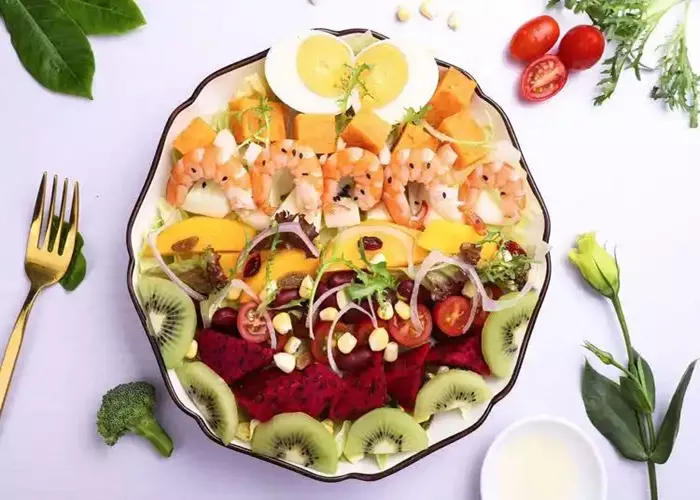Switching to a plant-based diet doesn’t have to be overwhelming. Whether you’re new to veganism or simply looking to streamline your meal prep, there are plenty of tips to make the transition smoother. Derek Simnett, a seasoned plant-based nutritionist and creator of the popular YouTube channel Simnett Nutrition, shares his expert advice on vegan food hacks that not only save time but also help reduce food waste and improve the taste of your dishes. Here are ten life-changing tips for anyone looking to upgrade their vegan cooking game.
1. Extend the Freshness of Greens
Fresh herbs like cilantro and parsley can wilt quickly in the fridge. Simnett recommends trimming the ends of these herbs, washing them, and storing them in a glass of water, similar to how you would store fresh flowers. This simple hack will keep your herbs vibrant and fresh for days. For green onions, the same method works—plus, they’ll even continue to grow when placed in water. Changing the water regularly is key to maximizing their lifespan.
2. Choosing Perfect Avocados
Avoid the frustrating guessing game of selecting ripe avocados. Simnett suggests opting for avocados with the small stem (or “button”) still attached, as they tend to be less prone to bruising and browning inside. For those wanting to buy in bulk, select firm avocados and let them ripen at home. If they ripen too quickly, simply pop them in the fridge to slow the process.
3. Managing Banana Ripeness
Bananas are notorious for ripening too quickly, but Simnett has a simple solution: store them in the fridge. Though the peel may darken, the fruit inside will remain fresh for a much longer time. For bananas that have already ripened, consider peeling and freezing them—perfect for smoothies or baking projects.
4. Smooth Nut Butter Mixing
Natural nut butters often separate, with oil floating to the top, making them difficult to mix. To solve this, Simnett recommends storing the jar upside down for a few days. This allows the oil to evenly distribute. Once opened, shaking the jar thoroughly ensures a smooth, creamy consistency without the mess.
5. Achieve an ‘Eggy’ Flavor with Kala Namak
Kala Namak, or black salt, is a must-have ingredient for replicating eggy flavors in vegan dishes. Its sulfur content adds an authentic taste to tofu scrambles and plant-based egg salads. A little goes a long way, transforming your dish with an unmistakable egg-like flavor.
6. Nut and Seed Crumble for a Cheesy Touch
Simnett’s recipe for a vegan “cheese” crumble involves blending nuts and seeds like cashews, almonds, and sunflower seeds with nutritional yeast and spices. The addition of apple cider vinegar helps the mixture clump together, creating a flavorful topping that can be sprinkled on salads, pastas, or stir-fries. It’s a great way to add texture and flavor to your meals.
7. Don’t Overlook Frozen Produce
While some may assume fresh is always better, Simnett champions the use of frozen fruits and vegetables. These items are often frozen at peak ripeness, locking in their nutrients. Frozen produce is not only convenient but also budget-friendly, making it a great addition to smoothies, soups, and stir-fries. Plus, it helps reduce food waste.
8. Grind Flax and Chia Seeds for Better Nutrient Absorption
Flax and chia seeds are rich in omega-3 fatty acids, but the body absorbs them more efficiently when they are ground. Simnett recommends using a coffee grinder or high-speed blender to break them down before consumption. This ensures you’re getting the full nutritional benefits of these tiny powerhouses.
9. Cook Grains and Legumes Together
Simnett suggests cooking mixed grains and legumes together for added texture and nutrition. Combining grains like quinoa and white rice with lentils can diversify the amino acid profile of your meals. He advises rinsing them thoroughly before cooking to remove any bitterness and enhance digestion. To avoid uneven cooking, choose grains and legumes with similar cook times.
10. Quickly Spot Non-Vegan Ingredients
Identifying non-vegan ingredients doesn’t have to be a chore. Instead of scanning through entire ingredient lists, Simnett suggests checking the “contains” section at the bottom of labels, where common allergens like milk and eggs are listed. This quick scan can save you time and effort while grocery shopping. Also, don’t be alarmed by “may contain” warnings—they typically refer to cross-contamination risks rather than confirmed animal-derived ingredients.
With these simple yet effective vegan food hacks, meal prep becomes less of a challenge and more of an enjoyable, sustainable practice. Whether you’re just beginning your plant-based journey or looking to optimize your routine, these tips can enhance your cooking while reducing waste and boosting your nutrition.
Related Topics:
What Is The Best Oatmeal To Eat For Weight Loss


